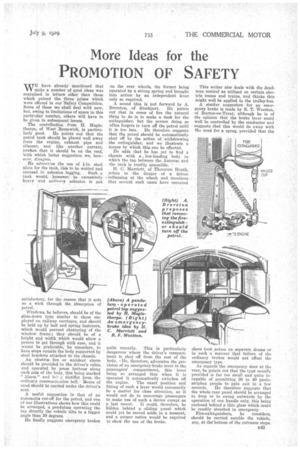More Ideas for the PROMOTION OF SAFETY
Page 101

If you've noticed an error in this article please click here to report it so we can fix it.
WE have, already mentioned that quite a number of good ideas was contained in letters other than those which gained the three prizes which were offered in our 'Safety Competition. Some of these we shall deal with now, but, owing to limitations of space in this particular number, others will have to be given in subsequent issues.
The contribution from H. Maplethorpe, of West Bromwich, is particu larly good. He points out that the petrol tank should be placed well away from the engine, exhaust pipe and silencer, and like another entrant, prefers that it should be on the roof, with which latter suggestion we, however. disagree.
Pie advocates the use of On, steel plate for the tank, this to be welded and encased in asbestos lagging. Such a tank would, however; be excessively heavy and ordinary asbestos is not satisfactory, for the reason that it acts as a wick through the absorption of petrol.
Windows, he believes, should be of the slide-down type similar to those employed on railway carriages, and should be held up by ball and spring fasteners, which would prevent chattering of the window frame; they should be of a height and width which would allow a person to get through with ease, and it would be preferable, he considers, to have steps outside the body supported by steel brackets attached to the chassis.
An electric fire or accident alarm should be provided in the driver's cabin and operated by press buttons along each side of the body, this being marked "
Alarm" and beig distinct from the ordinary communication bell. Boxes of sand should be carried under the driver's seat.
A useful suggestion is that a an automatic cut-off for the petrol, and one of our illustrations shows bow this could be arranged, a pendulum operating the tap directly the vehicle tilts to a bigger angle than 30 degrees.
He finally suggests emergency brakes on the rear wheels, the former being operated by a strong spring and brought into action by an independent lever only as required.
A sound idea is put forward by A. Brereton, of gtockport. Ile points out that in cases of fire the natural thing to do is to make a dash for the extinguisher, but the person doing so often forgets to turn off the petrol until it is too late. He therefore suggests that the petrol should be automatically shut off by the action of withdrawing the extinguisher, and we illustrate a means by which this can be effected.
He adds that he has yet to find a chassis with a , low-loading body in which the tap between the Antovac and the tank is readily accessible.
H. C: Marriott, of Thornton Heath,. refers to the danger of a driver. collapsing at the wheel; and. mentions . that several such cases have occurred quite recently. This is particularly dangerous where the driver's compartment is shut off from the rest of the body. -He, therefore, advocates the provision of an emergency-brake lever in the passengers' compartment, this lever being so arranged that when it is operated it automatically switches off
the engine. The exact position and fitting of such a lever would necessarily be a matter for close attention, as it would not do to encourage passengers to make use of such a device except as a last resort. It could, therefore, be hidden behind a sliding panel which could yet be moved aside in a moment, and a proper notice would be required to show the use of the brake. This writer also deals with the deadman control as utilized on certain electric trains and trains, and thinks this might well be applied to the trolley-bus.
A similar suggestion forrn an emergency brake is made by R. T. Wootton, of Burton-on-Trent, although he is of the opinion that the brake lever could well be controlled by the conductor and suggests that this would do away with the need for a sprag, provided that the , shoes took action on separate drums or in such a manner that failure of the ordinary brakes would not affect the emergency type.
As regards' theemergency door at the rear, he points out that the type usually provided is far too small and quite incapable of permitting 30 to 40 panicstricken people to gain exit in a few seconds. He therefore suggests that the whole rear panel should be arranged to drop or to swing outwards by the operation of one handle only, this being enclosed behind a thin glass which could be readily smashed in emergency.
Fire-extinguishers, he considers, should be carried outside the vehicle, say, at the bottom of the entrance steps.
















































































































































































